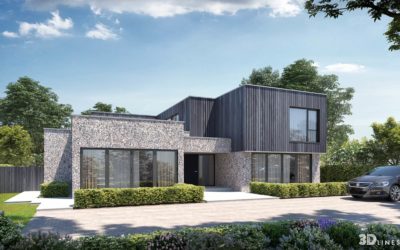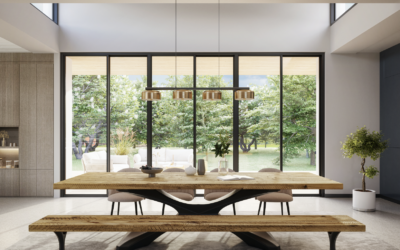The Power of 3D Rendering and Photography

The good old days of traditional marketing are almost behind us—the real estate market is going digital! This includes both 3D rendering and photography. Although there is an inherent difference between the two, the combination benefits visual marketing as a whole.
Your clients must fully understand your plan for the project before it can get off the ground. Your ability to present your ideas in a way that is both clear and engaging will directly impact how successful they are. And that can be achieved with 3D rendering and photography.
Difference between 3D Rendering and Photography Unites the Benefits
Capturing reality is the essence of photography while creating from imagination is the bottom line of 3D rendering.
A finished product can be showcased through pictures, but 3D rendering provides maximum flexibility, effectiveness, and overall impact. Many real estate creatives are turning to 3D as a go-to design tool because of its versatility and ability. 3D renderings are an easy way to showcase adjustments and display a finished project at any point in the process.
Before construction begins, photorealistic 3D renderings created by an architectural rendering company can be used to show off the design in all its glory. It’s also possible to generate a compelling visual narrative by blending CGI with photography.
The question now is, how does combining the two (3D rendering and photography) strengthen real estate development?
- Mixing Reality and Imagination
Combining actual photographs and 3D renders in the upcoming result of a real estate development shows the overlapping of the real world and an imaginative vision.
Including 3D images in your social media posts can give your content a new depth. Demonstrate the transformation of a 3D model into a physical structure to captivate your audience with your visual narrative. First, provide a photorealistic 3D rendering of your project, and then provide updates on its progress via site photographs.
This will allow your followers to see precisely what was in the 3D rendering of the unfinished construction of your website. Due to the attractiveness of the presentation, your follower count will increase swiftly. It is also likely that some of these followers will eventually become your customers.
- Comparing 3D Design with a Completed Real Estate Project
Having two pictures at hand, one envisioned and the other the actual finished project, can incorporate the two aspects into making a vision into reality.
You must eliminate any lingering worries in the minds of potential clients about your ability to execute on your promises. Developing trust is easy when you post a realistic 3D rendering next to actual photos of the completed building.
It’s possible to see the design you came up with in 3D. On the other hand, the photos will depict how it looks in action. Trust will easily be established when you show how similar the actual structure is compared to its 3D render. This is a great way to keep your audience engaged and entertained.
- Before and After Photos Encourage Clients
When it comes to hiring a contractor to help them renovate their house, homeowners have a lot of options. But ultimately, they want to make sure that the architect can bring the house back to life and make it more beautiful and pleasant than before.. To demonstrate your expertise in reconstruction and restoration, you must utilize 3D rendering and photos.
The question is, in what ways will CGI in real estate make it easier for you to establish your professional worth?
It is not necessary to wait until the completion of construction to present the genuine before/after images. As an alternative, you can share a snapshot of the current state of a building with 3D renderings of what it will look like when it’s completed. Thanks to a well-done architectural rendering, your potential clients can be persuaded that their houses will look even better once you’ve restored them.
- Photo-Matching in the Actual Location Lessens Hassle
It isn’t just for marketing objectives that 3D rendering and photography can be beneficial. Looking for a solution to cut expenses, speed up the process, and ensure that the place is accurately reproduced in your 3D images for your project? CGI provides a simple and effective solution.
Photo-matching is a Photoshop method that allows a CG rendering of a future building to be seamlessly integrated into an image of an existing site.
To speed up the process of photo-matching for a 3D artist, you need to supply them with a high-quality picture of the site. They just need to design the building’s rendering with this method. Creating the complete environment in 3D is unnecessary.
Consequently, you’ll obtain a photorealistic representation of your project, complete with the original photograph’s camera angle, lighting, and weather. Using this image as pre-sale marketing collateral is a good idea.
- Creating Great Real Estate Visuals for Social Media
Updating the images on your website or social media accounts might be time-consuming. It is best to use professional photographs of completed structures. You may not have pictures of your construction job because it takes time.
This issue can be solved with CGI pictures. Promoting your project early on could be aided by 3D rendering. These can be renderings of potential properties’ interiors and exteriors in a variety of lighting and time of year. 3D renderings can be used to highlight current project results, while pictures can be used to show completed projects. You’ll never run out of interesting material if you combine 3D rendering with photography.
Visuals Are Important
As much as we don’t want to judge the physical appearance of one person, this isn’t the case for real estate.
The most obvious way to demonstrate the tangible results of your effort is by displaying high-quality images. However, because planning and constructing a building is lengthy, taking pictures of the finished product can take some time. Prospective customers are unlikely to be enticed by construction-in-progress images so giving them an idea of what the finished product looks like will be more effective.
That’s why a hybrid of photography and 3D rendering is important. It emphasizes that in real estate, visuals matter!






